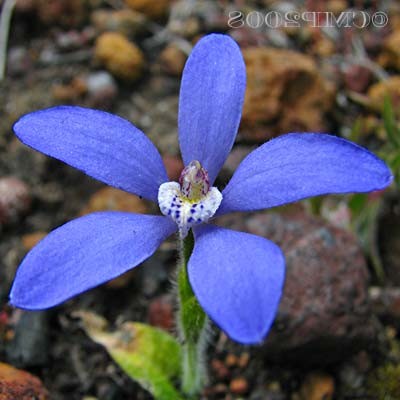Blue China Orchid
(Caladenia gemmata)

Description
Caladenia gemmata, commonly known as the blue china orchid, is a plant in the orchid family Orchidaceae and is endemic to the south-west of Western Australia. It has a small, oval leaf and up to three intense blue to mauve flowers. It is the most common and widespread of the West Australian china orchids, sometimes appearing in large numbers after summer fires. Caladenia gemmata is a terrestrial, perennial, deciduous, herb with an underground tuber. It has a single dark green, shiny leaf, 20–40 mm (0.8–2 in) long, 10–20 mm (0.4–0.8 in) wide and purplish underneath. Up to three intense blue to purplish flowers 20–50 mm (0.8–2 in) long and wide are borne on a stalk 40–150 mm (2–6 in) tall. The dorsal sepal is erect, 20–30 mm (0.8–1 in) long and 5–10 mm (0.2–0.4 in) wide. The lateral sepals and petals have about the same dimensions as the dorsal sepal. The labellum is 5–8 mm (0.2–0.3 in) long, 5–7 mm (0.2–0.3 in) wide, purple and blue and curves downward near its tip. There are many scattered small, bead-like calli covering the labellum. Flowering occurs from August to early November. Caladenia gemmata was first formally described in 1840 by John Lindley and the description was published in A Sketch of the Vegetation of the Swan River Colony. In 2000, Stephen Hopper and Andrew Brown changed the name to Cyanicula gemmata, but in 2015, as a result of studies of molecular phylogenetics Mark Clements changed the name back to Caladenia fragrans. The specific epithet (gemmata) is a Latin word meaning "with buds, eyes or jewels" referring to the labellum calli. The blue china orchid is a common and widespread china orchid found between Kalbarri in the north and Israelite Bay in the east, growing in a range of habitats from heath to forest. Plants growing in wetter areas tend to flower more profusely after summer fires.
Taxonomic tree:







